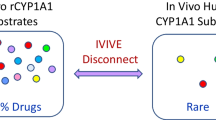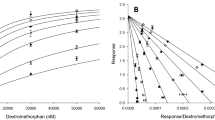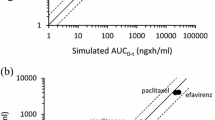Abstract
Objective
Macrolide antibiotics are mechanism-based inactivators of CYP3A enzymes that exhibit varying degrees of inhibitory potency. Our aim was to predict quantitatively the drug-drug interaction (DDI) potential of five macrolides from in vitro studies using testosterone as the CYP3A substrate, and to compare the predictions generated from human liver microsomal and recombinant CYP3A4 data.
Methods
The in vitro kinetic constants of CYP3A inactivation (K I and k inact) were estimated by varying the time of pre-incubation and the concentration of troleandomycin, erythromycin, clarithromycin, roxithromycin or azithromycin. CYP3A activity was determined from the measurement of testosterone 6β-hydroxylation with human liver microsomes (HLM) and recombinant CYP3A4 as the enzyme sources. The mechanism-based pharmacokinetic model was fitted with inactivation data to predict the increase in oral area under the plasma concentration-time curve (AUC) for midazolam.
Results
All five macrolides inactivated testosterone 6β-hydroxylation by HLM and recombinant CYP3A4 with k inact values in the range of 0.023 to 0.058 min−1. The potency of inactivation (K I) was higher using recombinant CYP3A4 as the enzyme source. The oral AUCs for midazolam were predicted from HLM data to increase 16.6, 5.3, 4.6, 1.6 and 1.2-fold due to the inhibition of metabolic clearance by troleandomycin, erythromycin, clarithromycin, roxithromycin and azithromycin, respectively. These results are within the range of the AUC ratios reported for clinical DDI studies. The predicted AUC increases generated using recombinant CYP3A4 overestimated the magnitude of the DDIs.
Conclusions
The DDI potential of five macrolide antibiotics was quantitatively predicted from in vitro studies using testosterone as the CYP3A substrate with HLM as the enzyme source.


Similar content being viewed by others
References
Zhou S, Chan E, Lim LY, Boelsterli UA, Li SC, Wang J, Zhang Q, Huang M, Xu A (2004) Therapeutic drugs that behave as mechanism-based inhibitors of cytochrome P450 3A4. Curr Drug Metab 5:415–442
Periti P, Mazzei T, Mini E, Novelli A (1992) Pharmacokinetic drug interactions of macrolides. [erratum appears in Clin Pharmacokinet 24:70] Clin Pharmacokinet 23:106–131
Kasahara M, Suzuki H, Komiya I (2000) Studies on the cytochrome P450 (CYP)-mediated metabolic properties of miocamycin: evaluation of the possibility of a metabolic intermediate complex formation with CYP, and identification of the human CYP isoforms. Drug Metab Dispos 28:409–417
Franklin MR (1991) Cytochrome P450 metabolic intermediate complexes from macrolide antibiotics and related compounds. Methods Enzymol 206:559–573
Delaforge M, Jaouen M, Mansuy D (1983) Dual effects of macrolide antibiotics on rat liver cytochrome P-450. Induction and formation of metabolite-complexes: a structure-activity relationship. Biochem Pharmacol 32:2309–2318
Pessayre D, Larrey D, Vitaux J, Breil P, Belghiti J, Benhamou JP (1982) Formation of an inactive cytochrome P-450 Fe(II)-metabolite complex after administration of troleandomycin in humans. Biochem Pharmacol 31:1699–1704
Tinel M, Descatoire V, Larrey D, Loeper J, Labbe G, Letteron P, Pessayre D (1989) Effects of clarithromycin on cytochrome P-450. Comparison with other macrolides. J Pharmacol Exp Ther 250:746–751
Yamano K, Yamamoto K, Katashima M, Kotaki H, Takedomi S, Matsuo H, Ohtani H, Sawada Y, Iga T (2001) Prediction of midazolam-CYP3A inhibitors interaction in the human liver from in vivo/in vitro absorption, distribution, and metabolism data. Drug Metab Dispos 29:443–452
Wang Y, Jones DR, Hall SD (2004) Prediction of cytochrome P450 3A inhibition by verapamil enantiomers and their metabolites. Drug Metab Dispos 32:259–266
Kanamitsu S, Ito K, Green CE, Tyson CA, Shimada N, Sugiyama Y (2000) Prediction of in vivo interaction between triazolam and erythromycin based on in vitro studies using human liver microsomes and recombinant human CYP3A4. Pharm Res 17:419–426
Ito K, Ogihara K, Kanamitsu S, Itoh T (2003) Prediction of the in vivo interaction between midazolam and macrolides based on in vitro studies using human liver microsomes. Drug Metab Dispos 31:945–954
Mayhew BS, Jones DR, Hall SD (2000) An in vitro model for predicting in vivo inhibition of cytochrome P450 3A4 by metabolic intermediate complex formation. Drug Metab Dispos 28:1031–1037
Silverman RB (1995) Mechanism-based enzyme inactivators. Methods Enzymol 249:240–283
Kenworthy KE, Bloomer JC, Clarke SE, Houston JB (1999) CYP3A4 drug interactions: correlation of 10 in vitro probe substrates. Br J Clin Pharmacol 48:716–727
Wang RW, Newton DJ, Liu N, Atkins WM, Lu AY (2000) Human cytochrome P-450 3A4: in vitro drug-drug interaction patterns are substrate-dependent. Drug Metab Dispos 28:360–366
Kenworthy KE, Clarke SE, Andrews J, Houston JB (2001) Multisite kinetic models for CYP3A4: simultaneous activation and inhibition of diazepam and testosterone metabolism. Drug Metab Dispos 29:1644–1651
Galetin A, Clarke SE, Houston JB (2003) Multisite kinetic analysis of interactions between prototypical CYP3A4 subgroup substrates: midazolam, testosterone, and nifedipine. Drug Metab Dispos 31:1108–1116
Yuan R, Madani S, Wei X, Reynolds K, Huang S (2002) Evaluation of cytochrome P450 probe substrates commonly used by the pharmaceutical industry to study in vitro drug interactions. Drug Metab Dispos 30:1311–1319
Ernest CS, 2nd, Hall SD, Jones DR (2005) Mechanism-based inactivation of CYP3A by HIV protease inhibitors. J Pharmacol Exp Ther 312:583–591
Venkatakrishnan K, Obach RS (2005) In vitro-in vivo extrapolation of CYP2D6 inactivation by paroxetine: prediction of nonstationary pharmacokinetics and drug interaction magnitude. Drug Metab Dispos 33:845–852
Polasek TM, Elliot DJ, Lewis BC, Miners JO (2004) Mechanism-based inactivation of human cytochrome P4502C8 by drugs in vitro. J Pharmacol Exp Ther 311:996–1007
Lowry OH, Rosenbrough NJ, Farr L, Randall RJ (1951) Protein measurement with the folin phenol reagent. J Biol Chem 193:267–275
Palkama VJ, Ahonen J, Neuvonen PJ, Olkkola KT (1999) Effect of saquinavir on the pharmacokinetics and pharmacodynamics of oral and intravenous midazolam. Clin Pharmacol Ther 66:33–39
Gorski JC, Jones DR, Haehner-Daniels BD, Hamman MA, O’Mara EM, Jr., Hall SD (1998) The contribution of intestinal and hepatic CYP3A to the interaction between midazolam and clarithromycin. Clin Pharmacol Ther 64:133–143
Olkkola KT, Aranko K, Luurila H, Hiller A, Saarnivaara L, Himberg JJ, Neuvonen PJ (1993) A potentially hazardous interaction between erythromycin and midazolam. Clin Pharmacol Ther 53:298–305
Backman JT, Aranko K, Himberg JJ, Olkkola KT (1994) A pharmacokinetic interaction between roxithromycin and midazolam. Eur J Clin Pharmacol 46:551–555
Wang Y, Gorski JC, Hamman MA, Hall SD (2004) Age and sex effect on duration of CYP3A inhibition by clarithromycin. Drug Metab Rev 36:274
Galetin A, Burt H, Houston JB (2005) Prediction of time-dependent drug interactions-impact of parallel pathways, enzyme degradation and intestinal inhibition. Drug Metab Rev 37:38
Kuehl P, Zhang J, Lin Y, Lamba J, Assem M, Schuetz J, Watkins PB, Daly A, Wrighton SA, Hall SD, Maurel P, Relling M, Brimer C, Yasuda K, Venkataramanan R, Strom S, Thummel K, Boguski MS, Schuetz E (2001) Sequence diversity in CYP3A promoters and characterization of the genetic basis of polymorphic CYP3A5 expression. Nat Genet 27:383–391
Westlind-Johnsson A, Malmebo S, Johansson A, Otter C, Andersson TB, Johansson I, Edwards RJ, Boobis AR, Ingelman-Sundberg M (2003) Comparative analysis of CYP3A expression in human liver suggests only a minor role for CYP3A5 in drug metabolism. Drug Metab Dispos 31:755–761
Patki KC, von Moltke LL, Greenblatt DJ (2003) In vitro metabolism of midazolam, triazolam, nifedipine, and testosterone by human liver microsomes and recombinant cytochromes P450: role of CYP3A4 and CYP3A5. Drug Metab Dispos 31:938–944
Williams JA, Ring BJ, Cantrell VE, Jones DR, Eckstein J, Ruterbories K, Hamman MA, Hall SD, Wrighton SA (2002) Comparative metabolic capabilities of CYP3A4, CYP3A5, and CYP3A7. Drug Metab Dispos 30:883–891
McConn DJ 2nd, Lin YS, Allen K, Kunze KL, Thummel KE (2004) Differences in the inhibition of cytochromes P450 3A4 and 3A5 by metabolite-inhibitor complex-forming drugs. Drug Metab Dispos 32:1083–1091
Palamanda JR, Casciano CN, Norton LA, Clement RP, Favreau LV, Lin C, Nomeir AA (2001) Mechanism-based inactivation of CYP2D6 by 5-fluoro-2-[4-[(2-phenyl-1H-imidazol-5-yl)methyl]-1-piperazinyl]pyrimidine. Drug Metab Dispos 29:863–867
Schuetz EG, Yasuda K, Arimori K, Schuetz JD (1998) Human MDR1 and mouse mdr1a P-glycoprotein alter the cellular retention and disposition of erythromycin, but not of retinoic acid or benzo(a)pyrene. Arch Biochem Biophys 350:340–347
Pauli-Magnus C, von Richter O, Burk O, Ziegler A, Mettang T, Eichelbaum M, Fromm MF (2000) Characterization of the major metabolites of verapamil as substrates and inhibitors of P-glycoprotein. J Pharmacol Exp Ther 293:376–382
Yeates RA, Laufen H, Zimmerman T (1996) Interaction between midazolam and clarithromycin: comparison with azithromycin. Int J Clin Pharm Ther 34:400–405
Zimmerman T, Yeates RA, Laufen H, Scharpf F, Leitold M, Wildfeuer A (1996) Influence of the antibiotics erythromycin and azithromycin on the pharmacokinetics and pharmacodynamics of midazolam. Arzneim-Forsch 46:213–217
Acknowledgements
This work was supported by a grant from the National Health and Medical Research Council of Australia. Thomas M. Polasek is the recipient of an Australian post-graduate award. We thank Benjamin C. Lewis for the preparation of recombinant CYP3A4 and David J. Elliot for development of the testosterone 6β-hydroxylation assay. The authors declare that experiments with human liver tissue were approved by the Flinders Medical Centre Ethics Review Committee under current Australian law.
Author information
Authors and Affiliations
Corresponding author
Rights and permissions
About this article
Cite this article
Polasek, T.M., Miners, J.O. Quantitative prediction of macrolide drug-drug interaction potential from in vitro studies using testosterone as the human cytochrome P4503A substrate. Eur J Clin Pharmacol 62, 203–208 (2006). https://doi.org/10.1007/s00228-005-0091-x
Received:
Accepted:
Published:
Issue Date:
DOI: https://doi.org/10.1007/s00228-005-0091-x




